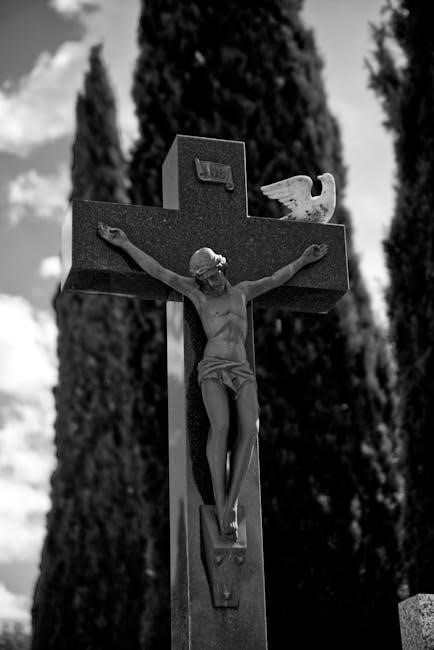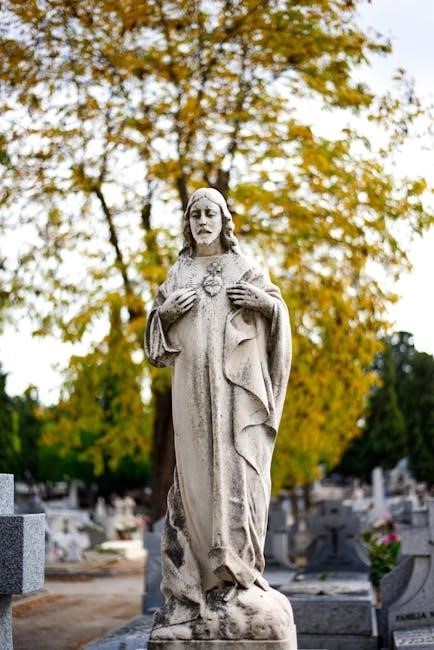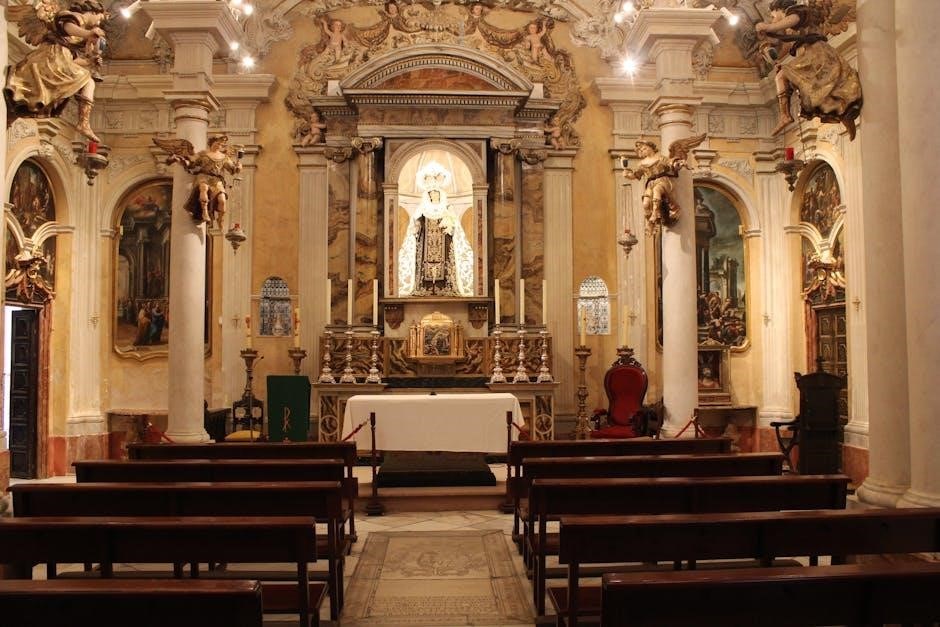1.1. Overview of the Divine Mercy Chaplet
The Divine Mercy Chaplet, revealed to Saint Faustina Kowalska, is a powerful Catholic devotion emphasizing God’s mercy. It consists of prayers recited using a rosary, including the Sign of the Cross, the Lord’s Prayer, Hail Mary, and the Creed, followed by specific mercy-focused petitions. The chaplet is often prayed for spiritual growth, healing, and divine grace, with promises of abundant mercy for those who pray it faithfully. Its simplicity and depth make it a beloved prayer worldwide.
The Divine Mercy Chaplet, rooted in Catholic devotion, is a prayer revealed to Saint Faustina Kowalska. It emphasizes God’s infinite mercy and is typically prayed using a rosary. The chaplet includes the Sign of the Cross, the Lord’s Prayer, Hail Mary, Creed, and specific petitions for mercy. Its simplicity and focus on divine grace have made it a popular devotion worldwide, with translations like the Spanish PDF version widely available for accessibility.
1.2. Importance of the Chaplet in Catholic Devotion
The Divine Mercy Chaplet holds a significant place in Catholic devotion as a powerful prayer for seeking God’s mercy. Its simplicity and profound focus on divine grace make it accessible to all. The chaplet is particularly cherished for its promises of abundant grace and healing, as revealed to Saint Faustina. Its availability in Spanish PDF formats has further expanded its reach, fostering devotion among Spanish-speaking communities worldwide.

History and Background of the Divine Mercy Chaplet
The Divine Mercy Chaplet originated from visions of Jesus received by Saint Faustina Kowalska in the 1930s. Jesus revealed the chaplet as a vessel of His mercy, promising grace and healing to those who prayed it. Its Spanish translation has spread devotion globally, emphasizing divine compassion and forgiveness.
2.1. The Vision of Saint Faustina Kowalska
Saint Faustina Kowalska, a Polish nun, received visions from Jesus in 1933, where He revealed the Divine Mercy Chaplet. Jesus presented Himself with rays of mercy, symbolizing grace and forgiveness. Faustina, known as the Apostle of Mercy, recorded these revelations, emphasizing prayer for divine compassion. Her writings, including the Spanish translation of the chaplet, have inspired global devotion, highlighting the promise of mercy for those who pray it with faith.
2.2. The Promises Associated with the Chaplet
Jesus, through Saint Faustina, promised abundant grace and forgiveness to those who pray the Divine Mercy Chaplet. He assured that souls devoted to His mercy would receive eternal blessings. A testimony mentions liberation from imprisonment, highlighting its miraculous power. The chaplet, available in Spanish as a PDF, offers a powerful tool for seeking divine compassion and spiritual renewal.

How to Pray the Divine Mercy Chaplet
Begin with the Sign of the Cross, followed by the Our Father, Hail Mary, and Creed. Recite the mercy-focused prayers, concluding with a final plea for divine grace. A Spanish PDF guide is available for devotion.
3.1. Step-by-Step Guide to Praying the Chaplet
Begin with the Sign of the Cross, reciting the Our Father, Hail Mary, and Creed. Next, pray the Divine Mercy prayers, repeating the “Eternal Father” and “For the sake of His sorrowful Passion” phrases. Conclude with three “Holy God” repetitions and a final plea for divine mercy. A Spanish PDF guide is available for reference, ensuring accurate recitation and devotion.
3.2. The Significance of Each Prayer in the Chaplet
The Divine Mercy Chaplet combines traditional prayers like the Our Father, Hail Mary, and Creed with unique prayers revealed to Saint Faustina. Each prayer emphasizes God’s mercy, forgiveness, and grace. The “Eternal Father” and “For the sake of His sorrowful Passion” prayers plead for mercy for various souls, reflecting the chaplet’s core message of divine compassion and trust in God’s infinite love. Spanish PDF guides ensure proper recitation and devotion.

The Divine Mercy Chaplet in Spanish
The Divine Mercy Chaplet in Spanish is a cherished devotion, offering solace and hope. Its translation preserves the original intent, making it accessible to Spanish-speaking faithful, fostering deep spiritual connection and trust in God’s mercy.
4.1. Translation and Cultural Relevance
The Divine Mercy Chaplet in Spanish is a faithful translation of the original, preserving its spiritual essence. It resonates deeply with Hispanic cultures, emphasizing God’s boundless mercy. The translation ensures accessibility for Spanish-speaking devotees, fostering a connection to the universal message of divine compassion. Its cultural relevance lies in its ability to adapt while maintaining the integrity of Saint Faustina’s revelations, making it a cherished devotion across Spanish-speaking communities.
4.2. PDF Resources for Spanish-Speaking Devotees
Spanish-speaking devotees can access PDF resources for the Divine Mercy Chaplet, offering translations of prayers, hymns, and reflections. These materials often include the chaplet’s origin, promises, and testimonies. Available online, they provide a convenient way to pray and share the devotion. Many PDFs are downloadable, making them ideal for personal use, group prayer, or distribution in religious communities.
The Divine Mercy Image
The Divine Mercy Image, featuring Jesus with rays of mercy, symbolizes God’s infinite compassion. It accompanies the chaplet, inspiring devotion and prayer, and is widely venerated worldwide.
5.1. The Iconography and Its Meaning
The Divine Mercy Image depicts Jesus as the Merciful Savior, with white and red rays emanating from His heart, symbolizing baptism and the Eucharist. The broken heart represents divine love and sacrifice. The background’s light and shade signify hope and redemption. This iconography, based on Saint Faustina’s visions, embodies God’s infinite mercy and compassion, inspiring devotion and prayer worldwide.
5.2. The Role of the Image in Prayer
The Divine Mercy Image serves as a focal point for prayer, reminding believers of God’s boundless mercy. Gazing at the image, devotees are inspired to reflect on Christ’s love and compassion. It accompanies the recitation of the chaplet, fostering a deeper connection to the divine. The image’s presence in homes, churches, and prayer spaces invites spiritual reflection and trust in God’s merciful promises, enriching the prayer experience.

The Promises and Graces of the Divine Mercy Chaplet
The chaplet offers profound spiritual benefits, including trust in God’s mercy, forgiveness of sins, and abundant grace. It is a powerful tool for miracles and healing, promising divine intervention for those who pray it with faith.
6.1. Spiritual Benefits for the Faithful
The Divine Mercy Chaplet offers numerous spiritual benefits, including deep trust in God’s mercy, forgiveness of sins, and inner peace. It strengthens faith, fosters reconciliation, and provides comfort in suffering. Praying the chaplet helps believers conform to God’s will and experience divine grace, leading to spiritual growth and a deeper connection with Christ.
6.2. Testimonies of Miracles and Healings
The Divine Mercy Chaplet has inspired countless testimonies of miracles and healings. Many believers report spiritual conversions, physical healings, and emotional peace after praying the chaplet. These experiences highlight God’s boundless mercy and the chaplet’s power to transform lives, offering hope and consolation to those who pray it with faith.
How to Incorporate the Chaplet into Daily Life
Pray the chaplet daily at 3 PM, the Hour of Mercy. Use a rosary or pray without one, focusing on God’s mercy. Share the chaplet with others to spread its blessings and inspire faith. Consistency strengthens spiritual growth and deepens trust in divine mercy.
7.1. Practical Tips for Daily Prayer
Start by dedicating a specific time, such as 3 PM, the Hour of Mercy. Use a rosary or pray without one, focusing on the chaplet’s simple structure. Begin with the Sign of the Cross, followed by the Our Father, Hail Mary, and Creed. Recite the mercy-focused prayers sincerely, even if time is limited. Consistency is key to spiritual growth and deepening trust in God’s mercy. Share the chaplet with others to spread its blessings.
7.2. The Chaplet as a Tool for Spiritual Growth
The Divine Mercy Chaplet fosters deep spiritual growth by emphasizing trust in God’s mercy. Its prayers, such as the Sign of the Cross and mercy-focused petitions, help cleanse the soul and strengthen faith. Praying it regularly at the Hour of Mercy (3 PM) deepens devotion and connection to divine love. This simple yet profound practice nurtures a heart of compassion and reliance on God’s grace.

The Chaplet and the Liturgical Calendar
The Divine Mercy Chaplet is deeply connected to the liturgical calendar, especially during Lent and Easter, culminating in Divine Mercy Sunday, a time of renewed devotion and reflection through prayer.
8.1. Celebrating Divine Mercy Sunday
Divine Mercy Sunday, the first Sunday after Easter, is a joyous celebration of God’s infinite mercy. It emphasizes the Divine Mercy Chaplet’s promises, revealed to Saint Faustina, offering spiritual renewal and grace. Many pray the chaplet in Spanish, fostering unity among diverse devotees. This day is a powerful reminder of Christ’s mercy, encouraging forgiveness and reconciliation, with resources like the Spanish PDF guiding faithful observance.
8;2. The Chaplet During Lent and Easter
The Divine Mercy Chaplet holds special significance during Lent and Easter, periods of spiritual renewal. Lent invites reflection on mercy, while Easter celebrates its triumph. Praying the chaplet in these seasons deepens devotion, offering a powerful way to seek forgiveness and share in Christ’s resurrection. Spanish PDF resources provide accessible guides for devotees, enriching their prayer journey during these sacred times.

The Chaplet in Spanish for Beginners
The Divine Mercy Chaplet in Spanish is a accessible devotion for newcomers. It begins with the Sign of the Cross, followed by the Our Father, Hail Mary, and Creed, using a rosary for guidance. Spanish PDF resources provide clear translations, making it easier for beginners to learn and pray the chaplet devoutly.
9.1. A Simple Guide for Newcomers
Begin by making the Sign of the Cross and praying the Our Father, Hail Mary, and Creed. Use a rosary to guide you through the chaplet’s structure. Repeat the mercy-focused petitions, such as “Oh fount of life, pour forth Your mercy” three times. Spanish PDF resources provide clear translations, making it easy to follow and pray devoutly. This simple yet profound devotion is perfect for those new to the Divine Mercy Chaplet.
9.2. Common Mistakes to Avoid
When praying the Divine Mercy Chaplet in Spanish, avoid rushing through the prayers or skipping essential parts like the Creed. Ensure the rosary is used correctly, repeating each petition three times as instructed. Mispronouncing Spanish words or skipping the introductory prayers can lessen the devotion’s impact. Use a reliable PDF guide to avoid errors and pray with heartfelt intention, focusing on the mercy and grace the chaplet embodies.
The Chaplet and the Rosary
The Divine Mercy Chaplet is prayed using a standard rosary, with each decade focusing on divine mercy rather than the mysteries of the Rosary. While both devotions use beads for structure, the Chaplet’s prayers emphasize God’s mercy and forgiveness, offering a unique spiritual focus distinct from the Rosary’s traditional format.
10.1. Similarities and Differences
The Divine Mercy Chaplet and the Rosary share structural similarities, as both use rosary beads and involve repetitive prayers. However, the Chaplet focuses specifically on divine mercy, while the Rosary reflects on the life of Christ. The Chaplet is shorter, with only 10 prayers per decade, unlike the Rosary’s 10 Hail Marys. Both devotions emphasize meditation and spiritual growth, but their themes and prayer content differ, catering to different spiritual needs and intentions. The Chaplet’s prayers, such as the “Eternal Rest” and mercy-focused petitions, distinguish it from the Rosary’s traditional format. Both, however, are powerful tools for deepening faith and connecting with God’s grace. They complement each other in Catholic devotion, offering unique spiritual benefits. The Chaplet’s simplicity and focus on mercy make it accessible, while the Rosary’s structure and mysteries provide a broader reflection on faith. Together, they enrich prayer life but serve distinct purposes in devotion and meditation.
10.2. Using the Rosary to Pray the Chaplet
The Divine Mercy Chaplet can be prayed using a standard rosary, with each decade dedicated to specific mercy-focused prayers. Start with the Sign of the Cross, followed by the Lord’s Prayer, Hail Mary, and Creed. Then, recite the mercy petitions on each bead, emphasizing divine mercy. The structure mirrors the rosary, making it familiar yet distinct in its focus. This method simplifies prayer for those accustomed to the rosary format, blending tradition with the Chaplet’s unique devotion to God’s mercy. Many Spanish-speaking devotees use rosary beads to pray the Chaplet, finding comfort in its familiar rhythm while deepening their understanding of divine compassion. The rosary’s tactile nature enhances meditation, helping to focus on the Chaplet’s powerful prayers. This approach makes the Chaplet accessible to those who already use the rosary for daily prayer, integrating mercy devotion seamlessly into their spiritual routine. It’s a practical way to combine two beloved Catholic devotions, fostering a deeper connection to faith and grace. By using the rosary, the Chaplet becomes a natural extension of familiar prayer practices, making it easier to embrace its spiritual benefits. This method is particularly helpful for newcomers, as it provides a structured yet flexible way to engage with the Chaplet’s prayers. Ultimately, the rosary serves as a timeless tool for praying the Divine Mercy Chaplet, bridging tradition and innovation in Catholic spirituality. It’s a testament to the versatility of both devotions, allowing the faithful to deepen their relationship with God through familiar and meaningful prayer practices. The rosary’s universal appeal ensures that the Chaplet’s message of mercy reaches a wide audience, fostering unity and spiritual growth among believers. This harmonious blend of traditions emphasizes the enduring power of prayer in connecting humanity with the divine. By praying the Chaplet on rosary beads, devotees can experience the richness of both devotions, enriching their spiritual journeys with every prayer. The rosary’s familiar structure provides a comforting foundation for the Chaplet’s unique petitions, creating a balanced and fulfilling prayer experience. This approach not only honors tradition but also invites innovation, ensuring that the Divine Mercy Chaplet remains a vibrant and accessible form of worship for generations to come.
The Divine Mercy Chaplet, now widely available in Spanish, remains a powerful devotion. Its accessible prayers and profound promises inspire global faith. Embrace and share it.
11.1. The Enduring Power of the Divine Mercy Chaplet
The Divine Mercy Chaplet, revealed to Saint Faustina, remains a timeless devotion. Its prayers, including the Sign of the Cross, Lord’s Prayer, and Creed, followed by mercy-focused petitions, offer profound spiritual benefits. Promises of abundant mercy and grace have made it a cherished practice. Available in Spanish, it continues to inspire millions, fostering faith and hope globally. Its enduring power lies in its simplicity and profound impact on souls seeking divine compassion.
11.2. Encouragement to Share the Chaplet with Others
Sharing the Divine Mercy Chaplet with others is a beautiful way to spread God’s mercy. Its simple prayers and profound promises make it accessible to everyone. Encourage others to embrace this devotion, as it offers hope, healing, and spiritual renewal. By sharing, you help others experience the loving compassion of Jesus, fostering a deeper connection with Him and His divine mercy.
